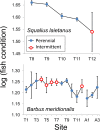Water abstraction affects abundance, size-structure and growth of two threatened cyprinid fishes
- PMID: 28414787
- PMCID: PMC5393870
- DOI: 10.1371/journal.pone.0175932
Water abstraction affects abundance, size-structure and growth of two threatened cyprinid fishes
Abstract
Hydrologic alteration is a major threat to freshwater biota, and particularly fish, in many river courses around the world. We analyzed and compared the effects of water abstraction on two threatened cyprinid fishes of contrasting ecology (the Mediterranean barbel Barbus meridionalis and the Catalan chub Squalius laietanus) in a Mediterranean stream. We compared abundance, size-structure, growth, and condition of both species across perennial and artificially intermittent reaches affected by water abstraction. Both species were less abundant, had scarce large individuals, and displayed slower growth rates (length-at-age) in intermittent reaches, showing clear detrimental effects of water diversion. Mixed-effect models of scale increments showed variation among individuals and among sites, years and age classes for both species. The larger-sized, water-column species (chub) disappeared or was rare in many intermittent reaches. The barbel present in intermittent reaches showed better somatic condition than in sites with permanent flow, perhaps due to reduced competition after rewetting or colonization by better fitted individuals. This benthic, rheophilic species seems more resilient to moderate water abstraction than chub. Many effects of water flow intermittency were only detected on fish life-history traits when accounting for natural, often non-linear, variation, along upstream-downstream gradients. Our results suggest that abundance was the strongest indicator of effects of water abstraction on fish populations, whereas condition was a more labile trait, rapidly recovering from anthropogenic disturbance.
Conflict of interest statement
Figures







References
-
- Sabater S, Tockner K. Effects of hydrologic alterations on the ecological quality of river ecosystems In: Sabater S, Barceló D, editors. Water Scarcity in the Mediterranean. Handbook Environmental Chemistry. Springer Verlag; 2010. pp. 15–39.
-
- García-Ruiz JM, López-Moreno JI, Vicente-Serrano SM, Lasanta–Martínez T, Beguería S. Mediterranean water resources in a global change scenario. Earth-Science Reviews 2011; 105(3): 121–139.
-
- Cooper SD, Lake PS, Sabater S, Melack JM, Sabo JL. The effects of land use changes on streams and rivers in mediterranean climates. Hydrobiologia 2013; 719(1): 383–425.
-
- Dudgeon D. Anthropocene Extinctions: Global Threats to Riverine Biodiversity and the Tragedy of the Freshwater Commons In: River Conservation: Challenges and Opportunities. Sabater S, Elosegi A, editors. BBVA Foundation; 2013. pp. 129–165.
-
- Gasith A, Resh VH. Streams in Mediterranean climate regions: abiotic influences and biotic responses to predictable seasonal events. Annual review of Ecology and Systematics 1999; 30: 51–81.
MeSH terms
Substances
LinkOut - more resources
Full Text Sources
Other Literature Sources

